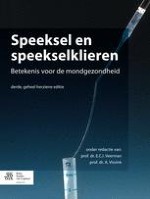2014 | OriginalPaper | Hoofdstuk
19. Cariës en speeksel
Auteurs : E.C.I. Veerman, A.J.M. Ligtenberg
Gepubliceerd in: Speeksel en speekselklieren
Uitgeverij: Bohn Stafleu van Loghum
Samenvatting
-
klaring van voedselresten uit de mond;
-
neutraliseren en verdunnen van zuur geproduceerd door plaquebacteriën;
-
leverancier van fosfaat- en calciumionen: bevordering remineralisatie van tandglazuur;
-
vorming van beschermende speekselpellicle: remming demineralisatie;
-
remmen van bacteriële aanhechting aan tandoppervlakken.
